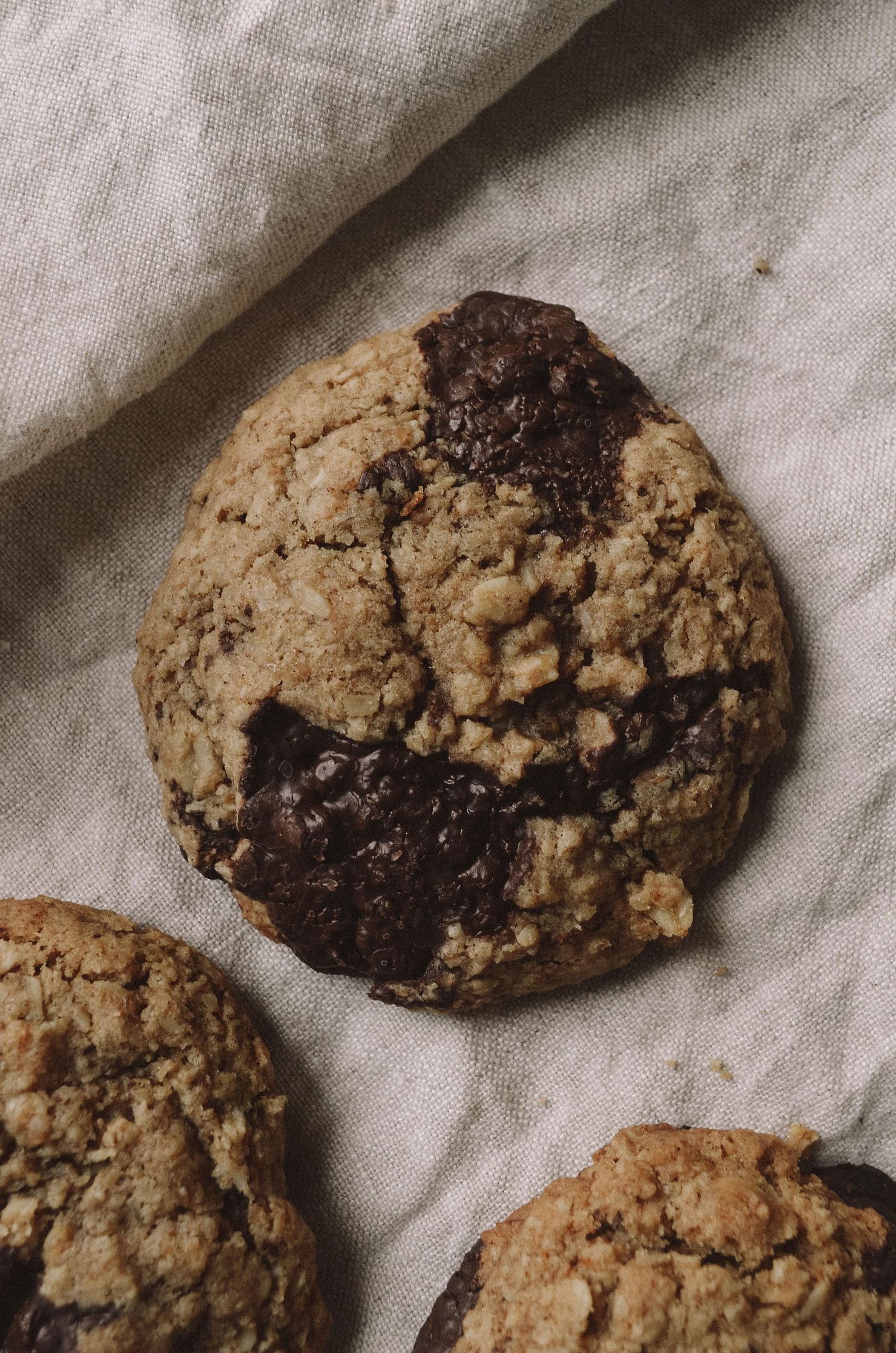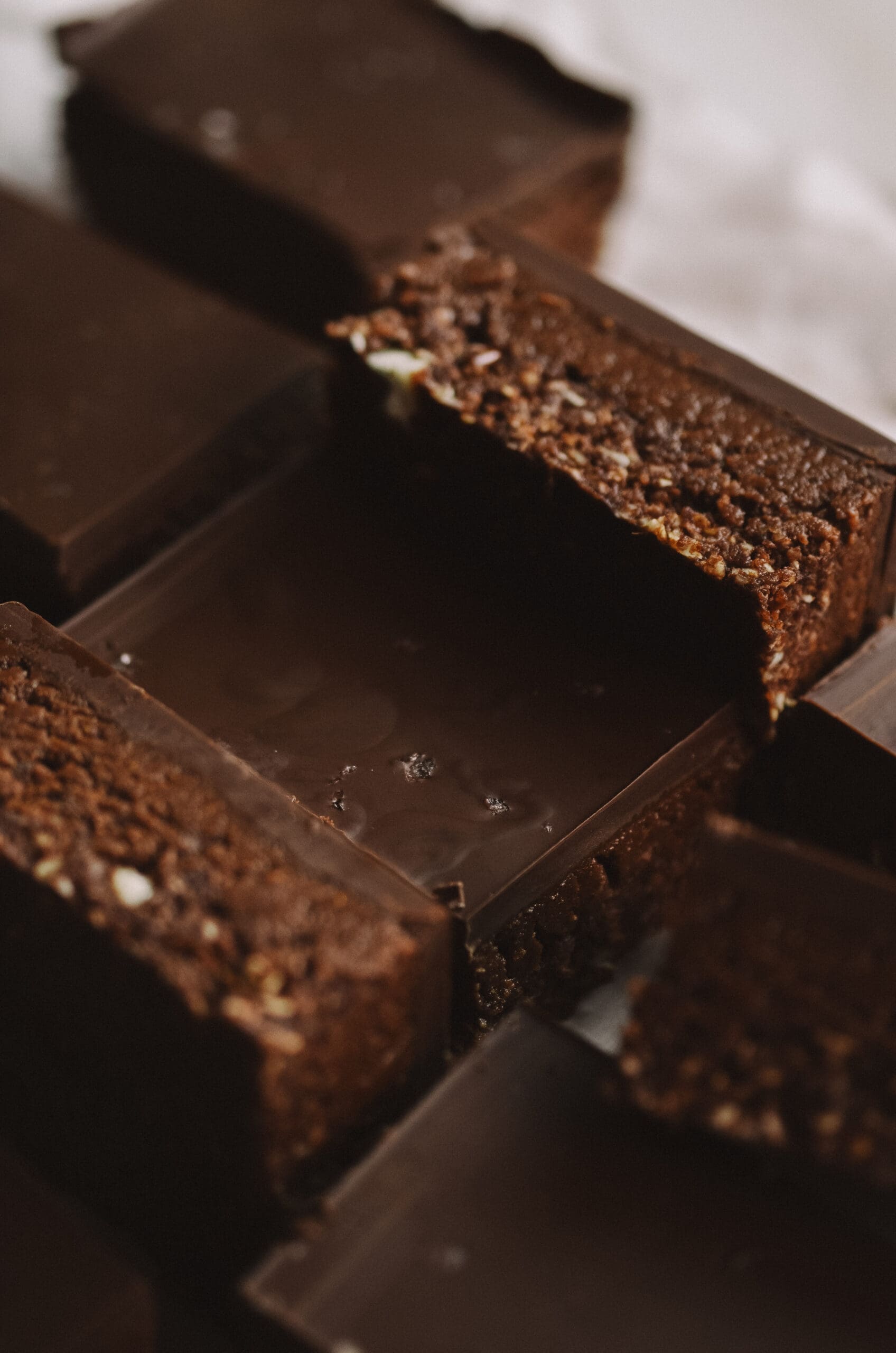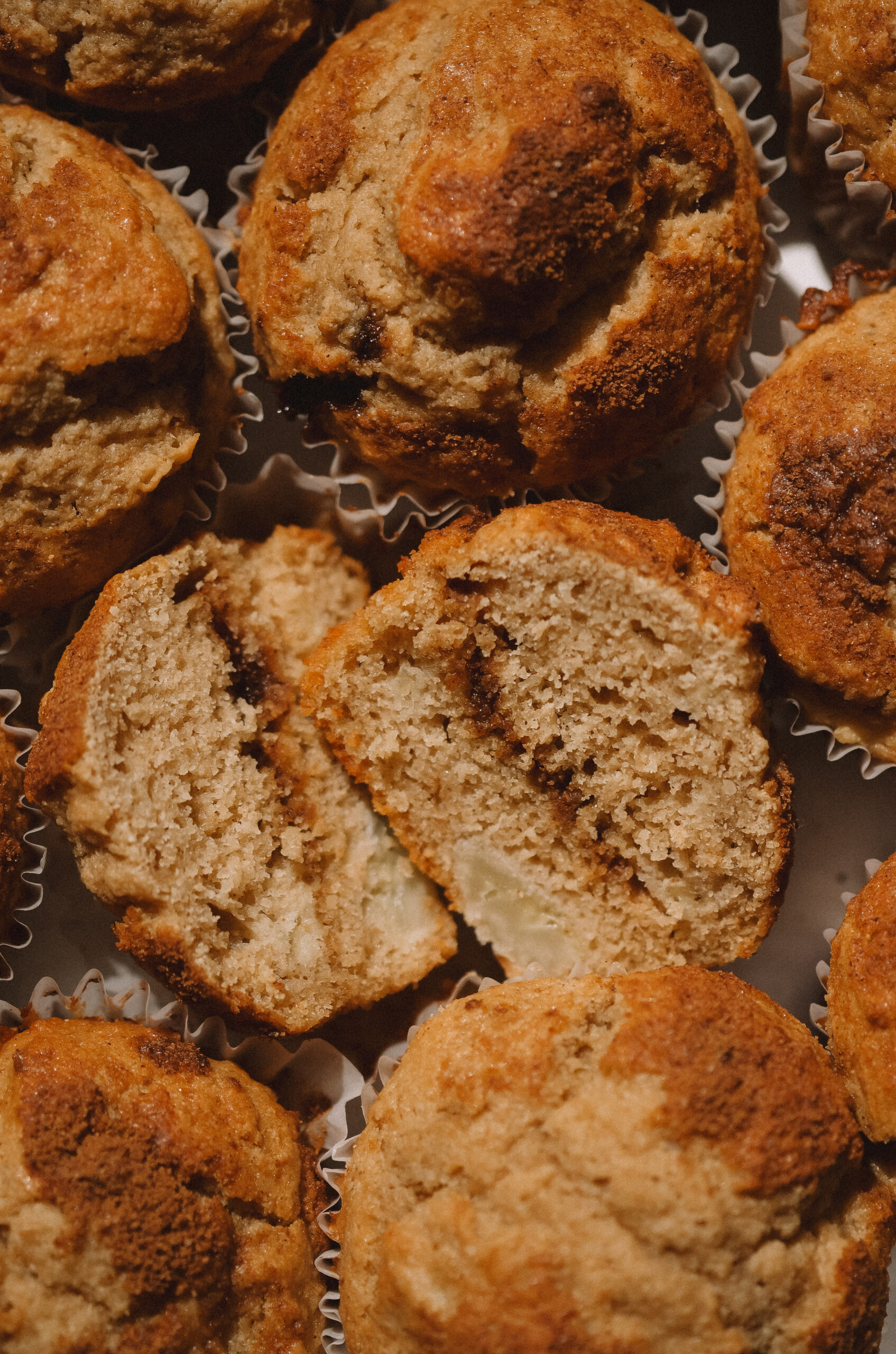Prep time: 30 minutes – overnight (see below)
Bake time: 10 minutes
Makes: 8-12
Sourdough in a cookie? Of course…
If you haven’t tried the oat + date chocolate cookie recipe from last month, I’d like to pause and send you in that direction first… it’s top-notch. These are essentially the same thing but with an added bonus of sourdough. It had been a while since I made a discard recipe and thought these cookies make the perfect canvas for one.
If a sourdough starter is an active part of your life, discard recipes will likely make their way into your life too. If you’re regularly feeding a starter, you soon realize that you end up tossing out more than you actually use… which makes you think, who came up with this system? It’s pretty wasteful. But it doesn’t have to be! Recipes like this one, along with thousands of others you can find across the internet, are a great way to salvage what would have ended up in the trash.

what’s sourdough discard?
If you’ve never had a sourdough starter, discard may sound like a foreign term. It also sounds like something you wouldn’t ever want to use in a recipe… so what exactly is this mysterious goop and why are we using it? PS – I have a FREE step-by-step guide to creating your first sourdough starter. You can grab it here!
Discard is essentially just extra sourdough starter. To keep your starter alive, you’ll need to regularly feed (or refresh) it. With each refreshment, you’ll have to toss some out; otherwise, you’ll end up with a very acidic result. Not to mention, you’ll be left with a ridiculous amount of it.
The stuff you toss out is considered “discard,” but the name is a bit misleading because it’s perfectly good to use! In a sense, it’s the byproduct of maintaining a healthy starter.
Instead of throwing it in the trash (or hopefully compost), you can add it directly to a recipe by mixing it in with the dough. It’ll leaven (help rise) bread, cookies, brownies, pancakes, really anything you’re willing to experiment with. And the bonus? If you’re discarding the starter at peak hydration (its most active state), you won’t have to wait to build another levain for a loaf, that’s 4-10 hours you can save! I like to call it the lazy gal’s guide to sourdough baking.
how to use fresh discard in place of a levain:
In my book, there are no hard and fast rules when it comes to using discard for baked goods. I usually measure out 75-150g depending on the size of the recipe and how much “lift” I want it to have. Then, I’ll typically add a few extra Tbsp’s of a sweetener, and maybe an oil like ghee, coconut, olive, or butter – whatever the recipe already uses.
Using discard for a sourdough loaf is a bit different. You’d want to make sure it’s fresh discard coming straight from a starter that has just reached peak hydration (aka, we’re not using stored discard from the fridge). Secondly, you’d be using the discard in replace of the levain, so it’s important you follow the recipe closely.
Here’s what I suggest:
1. Pre-mix (autolyze) the flours per the recipe’s instructions.
2. Let the flour sit for however long the recipe calls for – I usually do 1 – 1h 30m.
3. Replace the levain with equal parts discard: If the recipe needs 100g of levain, measure 100g of discard and add it straight to the pre-mixed flour.
4. Follow the remaining instructions per usual!
storing discard:
If you don’t plan on using the discard right away, cool! You can tuck it away in the fridge for a week or so and go on with life. The lower temp slows down fermentation so it won’t require regular feedings, you can almost think of the yeasts as going into hibernation. Sorta neat? Over the course of the week, you can add it to directly to pancake batter, brownies, zucchini bread, pie crust, scones, muffins, you get the point, go wild with it!
Side note – some people store discard longer than a week, totally fine, in fact, I’ve used 3-week-old hibernating discard for a rhubarb pie and no one got sick…just check on it once and a while to make sure it’s not growing anything funky (you might be shocked to see what the thing can grow).
why use sourdough discard?
Simply put: sourdough discard adds a ton of flavor. The yeasts help your ingredients to ferment and fuse together, morphing into something that’s unparalleled if you ask me. But, there are other reasons too: it’s a huge time saver, improves digestibility, gives your dessert an added facelift, and greatly cuts down on waste! If we haven’t already hit it home, maintaining a starter gets quite wasteful as you toss a little out with each feeding (my compost is practically all starter, post-storage). If you’re using your starter frequently, discard recipes will be a lifesaver.
on to the recipe:
As I mentioned, this recipe is basically an exact replica of the oat + date cookie. I added about 75g of discard, and 2 extra Tbsp’s of coconut sugar. That’s it! If you decide to give it a shot, play around with the discard amount and see how the texture feels. If it needs more moisture, add a Tbsp of coconut oil and go from there. You can also let it rest longer in the fridge. The recipe is forgiving. For other considerations, be sure to take a look at the other recipe!

considerations:
1. These cookies have a very small amount of baking soda, so they won’t rise much in the oven. I recommend shaping them into the size / thickness you want to end up with.
2. You can sub 2 flax eggs for 1 large egg. Add the egg with the liquid mixture once the oil has cooled completely (if the oil is hot, it will begin to cook the egg & believe me, you don’t want this).
3. If you don’t have brown rice flour, you could replace this with cassava flour, millet flour, or more oat flour, millet flour. I wouldn’t recommend coconut flour or more almond flour in this case as the higher fat content could change the cookie, likely requiring more liquid.
4. This recipe is naturally gluten-free, but if gluten is a concern of yours, be sure the oats you use are labeled certified gluten-free – conventionally grown oats are often contaminated.
ingredients
6 dates
1 ½ c oats
½ c brown rice flour
½ c maple syrup
⅓ c coconut oil, melted
¼ c desiccated coconut
3 Tbsp arrowroot flour
4 Tbsp coconut sugar
2 Tbsp ghee *see note
2 flax eggs (2 Tbsp ground flax + 4 Tbsp water)
1 ½ tsp vanilla
½ tsp cinnamon
½ tsp baking soda
½ tsp sea salt + a sprinkle to top
dark chocolate, chopped
75g sourdough discard
steps
Chop the dates (remove the pits if they have them) and dark chocolate, set aside.
Blend one cup of the oats in a coffee grinder, blender, or small food processor until you reach a flour consistency.
Once blended, add the oat flour to a medium bowl. Add the remaining whole oats, brown rice flour, desiccated coconut, coconut sugar, cinnamon, baking soda, and sea salt then mix.
Add the dates and stir to coat – this should help avoid the dates from clumping together. Add the chocolate, followed by the arrowroot, mix again, then set aside.
Mix the flax egg, then set aside.
In a saucepan, melt the coconut oil and ghee over low heat. Once melted, remove from heat and let it cool for a few minutes. Add the maple syrup, sourdough discard, and vanilla, then mix. Pour this mixture into the dry ingredients and give it a good stir. Everything should be well combined.
Fold in the flax egg – a few folds is plenty, do not overmix this.
Place in the fridge for 15-20 minutes to let everything infuse together. This step is important. While they’re in the fridge, preheat the oven to 375°F and line a large tray with parchment paper.
After the time has elapsed, shape the cookies into your preferred size *see consideration #1. Top with flaky sea salt and place in the oven and bake for about 10 minutes. Check on them and see if they need another minute or two. Bake until golden brown and not completely firm – they’ll continue to cook for a few minutes after baking.

the sourdough oat + date cookie
Ingredients
- 6 dates
- 1 ½ c oats
- ½ c brown rice flour
- ½ c maple syrup
- ⅓ c coconut oil, melted
- ¼ c desiccated coconut
- 3 Tbsp arrowroot flour
- 4 Tbsp coconut sugar
- 2 Tbsp ghee *see note
- 2 flax eggs, 2 Tbsp ground flax + 4 Tbsp water
- 1 ½ tsp vanilla
- ½ tsp cinnamon
- ½ tsp baking soda
- ½ tsp sea salt + a sprinkle to top
- dark chocolate, chopped
- 75 g sourdough discard
Instructions
- Chop the dates (remove the pits if they have them) and dark chocolate, set aside.
- Blend one cup of the oats in a coffee grinder, blender, or small food processor until you reach a flour consistency.
- Once blended, add the oat flour to a medium bowl. Add the remaining whole oats, brown rice flour, desiccated coconut, coconut sugar, cinnamon, baking soda, and sea salt then mix.
- Add the dates and stir to coat – this should help avoid the dates from clumping together. Add the chocolate, followed by the tapioca, mix again, then set aside.
- Mix the flax egg then set aside.
- In a saucepan, melt the coconut oil and ghee over low heat. Once melted, remove from heat and let it cool for a few minutes. Add the maple syrup, sourdough discard, and vanilla, then mix. Pour this mixture into the dry ingredients and give it a good stir. Everything should be well combined.
- Fold in the flax egg – a few folds is plenty, do not over mix this.
- Place in the fridge for 15-20 minutes to let everything infuse together. While they’re in the fridge, preheat the oven to 375F and line a large tray with parchment paper.
- After the time has elapsed, shape the cookies into your preferred size *see consideration #1. Top with flaky sea salt and place in the oven and bake for about 10 minutes. Check on them and see if they need another minute or two. Bake until golden brown and not completely firm – they’ll continue to cook for a few minutes after baking.







I made these with a few changes: raisins and chocolate chips instead of dates and coconut. Also put them in an 8×8 instead of shaping cookies. In the oven now!
One thing to note: ingredients call for arrow root but instructions say “tapioca”.
Thank you so much for that catch! Fixed. I hope you enjoyed these!
These cookies are amazing! So soft, easy to make and they are the perfect treat. I highly recommend making these.
So glad you like them!! 🥰